Engineering-based Quantification of Cerebrospinal Fluid Dynamics and Central Nervous System Tissue Dynamic Motion Using Non-invasive Magnetic Resonance Imaging in Type I Chiari Malformation
Williams, Gwendolyn. (2021-05). Engineering-based Quantification of Cerebrospinal Fluid Dynamics and Central Nervous System Tissue Dynamic Motion Using Non-invasive Magnetic Resonance Imaging in Type I Chiari Malformation. Theses and Dissertations Collection, University of Idaho Library Digital Collections. https://www.lib.uidaho.edu/digital/etd/items/williams_idaho_0089n_12068.html
- Title:
- Engineering-based Quantification of Cerebrospinal Fluid Dynamics and Central Nervous System Tissue Dynamic Motion Using Non-invasive Magnetic Resonance Imaging in Type I Chiari Malformation
- Author:
- Williams, Gwendolyn
- Date:
- 2021-05
- Keywords:
- Cerebrospinal fluid Chiari malformation Magnetic resonance imaging Neuroimaging Tissue displacement Tissue motion
- Program:
- Biological & Agricultural Engineering
- Subject Category:
- Biomedical engineering
- Abstract:
-
Chiari Type I Malformation (CMI) is a chronic central nervous system disease that is non- curatively treated with highly invasive brain surgery and has no standard metric to quantify successful surgery beyond symptom stabilization. The underlying CMI pathophysiology is not well understood, as the basis of this disease is physiologically tied to the flow of cerebrospinal fluid (CSF) but conflicting reports in literature have limited the use of CSF-based biomarkers for Chiari diagnosis and prognosis. The current standard for CMI diagnosis uses static morphometric measurements, which fail to relate to symptomology and therefore provide little basis for surgical outcome prediction and making appropriate surgical candidacy selection difficult. This research sought to address this issue of conflicting reports around CSF dynamics in CMI as well as work towards a better understanding of the underlying CMI pathophysiology.Our objective here was to address the need for improved neuroimaging CMI diagnostic practices by investigating current imaging modalities and underlying pathophysiology with clinically relevant neuroimaging techniques and advanced post-processing methods. With a specific focus on using clinically relevant research, we applied engineering principles taken from cardiac engineering and apply them to the brain for diagnostics and prognostics of CMI. First, to address the need for improved CSF dynamics measurement techniques, we quantified agreement, reproducibility, and repeatability of 4D Flow and 2D PC MRI measurements of CSF velocities at the craniovertebral junction using a CMI subject specific in vitro model. Next, we utilized modern MR imaging and post- processing techniques to quantify differences in cardiac-induced neural tissue motion with novel parameters to represent relative displacement between physiologically relevant regions of interest. We found an overall lack of reproducibility of PC MRI key measurements and dependent on the specific scanning machine used. With further research, machine-specific differences could be understood and potentially quantify these differences to develop a correctional calibration procedure. A standard calibration procedure could ensure results from any calibrated scanner are comparable to results from any other calibrated scanner. Our limited sample size showed preliminarily that neural tissue motion at the craniovertebral junction lacked statistically significant differences between patients and controls, neither before nor after posterior fossa decompression surgery. This finding is not supported nor rebuked by current literature regarding neural tissue motion in CMI, as reports are in great disagreement. There was some preliminary indication of a physiological relevance of relative neural tissue motion at craniovertebral junction. Relative neural tissue motion should be further studied with larger cohorts and imaging modalities with higher resolutions so that a biomarker could be defined that provides a better basis for surgical candidacy selection.
- Description:
- masters, M.S., Biological & Agricultural Engineering -- University of Idaho - College of Graduate Studies, 2021-05
- Major Professor:
- Schiele, Nathan
- Committee:
- Potirniche, Gabriel; Fu, Audrey; Qualls, Russell; Martin, Bryn
- Defense Date:
- 2021-05
- Identifier:
- Williams_idaho_0089N_12068
- Type:
- Text
- Format Original:
- Format:
- application/pdf
- Rights:
- In Copyright - Educational Use Permitted. For more information, please contact University of Idaho Library Special Collections and Archives Department at libspec@uidaho.edu.
- Standardized Rights:
- http://rightsstatements.org/vocab/InC-EDU/1.0/

